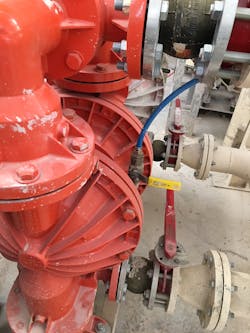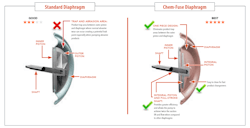The Future of AODD-Pump Diaphragms
When determining the level of performance of air-operated double-diaphragm (AODD) pumps, choosing the correct air motor is generally the most important choice the user will have to make. Also significant, however, is selecting the right type of diaphragm, the operation and reliability of which will directly impact the pump’s mean time between failure (MTBF), application safety, and operational efficiency and consistency. As the parts that are constantly in motion during an AODD pump’s operation – with any breakdowns or failures resulting in undeniably costly and oftentimes hazardous product leaks – careful consideration must be taken regarding diaphragm selection.
Over the years, it had become apparent to AODD manufacturers that improved diaphragm design was the next frontier in relation to better, more reliable pump performance. Driven by this belief, diaphragm manufacturers have discovered better ways to build diaphragms and make it easier to satisfy their operational demands.
Most significantly, the outer-piston abrasion that will occur during normal operation will eventually lead to the creation of a potential leak point. Abrasion caused by contact between the outer piston and the diaphragm is an unavoidable by-product of the operation of this type of diaphragm. Abrasion is exacerbated by the presence of abrasive particles in the fluid stream that can be trapped between the piston and the diaphragm. In many cases, this abrasive wear is the primary cause of diaphragm failure, regardless of the diaphragm material. This is not only expensive from lost product, maintenance and replacement perspectives, but also from a hazard standpoint if the pump is handling harmful or dangerous liquids.
The design of outer-piston diaphragms also can lead to the buildup of the pumped fluid, especially if it's abrasive. In this case, the abrasive substance can collect on the outer piston because standard diaphragms have flat outer pistons that feature pockets or areas where abrasive-type fluids can nest or be trapped. Another potential problem can occur when the thickness of the material buildup’s “skin” reaches a certain level and it shears off during the pumping process. Any buildup that enters the fluid stream possesses the capability to damage the pump or get stuck in the production system, which can lead to debilitating breakdowns, downtime and repair/replacement costs.
Considering the problems that abrasion wear and material buildup can cause, the industry worked diligently to develop the integral piston diaphragm, or IPD. Within the IPD design, the piston that is used to move the diaphragm laterally during the pumping stroke is encapsulated into the interior of the diaphragm itself. IPDs also have a smooth finish with an angle of operation that enhances fluid flow and suction lift while reducing the propensity for material buildup on the outer piston.
While Wilden did not invent the IPD, its engineers have been able to develop a unique IPD design that uses the same hardware as standard full-stroke diaphragms, which means there is no tradeoff in performance when using a Wilden IPD, something that can’t be said for other IPD-diaphragm designs.
Specifically, Wilden has designed two IPD models, both of which can achieve a traditional stroke length that will optimize flow rates, suction lift and efficiency.
Additional features of Chem-Fuse include:
- Elimination of outer piston abrasion for longer diaphragm life
- Easy cleanability for faster changeovers between product
- Up to 100% increased flow and suction lift compared to other reduced-stroke IPD diaphragms
- Chem-Fuse diaphragms are available in Wil-Flex™ and non-food grade Saniflex™ material
- Temperature range for Saniflex: from -29°C to 104°C (-20°F to 220°F)
To learn more, please visit psgdover.com/wilden.


